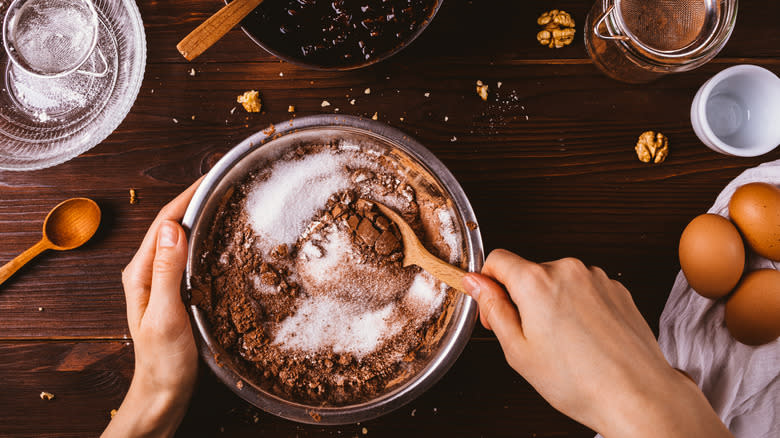One of my first EVER TikTok follows was the author of this recipe I’m about to rave over: Chef Jon Kung. He’s a Chinese American chef who appeared on my FYP making different condiments like chili oil, explaining spices, trying different cooking techniques, and talking about food and its place in society and culture.
He also introduced me to third-culture cooking, where people blend their unique makeup of food traditions, ingredients, and flavors into their food. As someone who’s learning about their heritage culture (I was adopted from China) and continuing to embrace their adopted culture of Jewish American cuisine, TikTok really said for you (IYKYK).
Kung Food: Chinese American Recipes from a Third-Culture Kitchen: A Cookbook
$28.52
Buy Now
All that to say, when I heard he was releasing his debut cookbook, Kung Food: Chinese American Recipes from a Third Culture Kitchen, and was offered the opportunity to get an early look, the answer was an immediate yes! I went straight to the noodle section and immediately found his ginger scallion noodles. The hardest part, I thought, was going to be making the ginger scallion oil. Spoiler: It was not hard.

Ginger Scallion Oil Is Liquid Gold (or Something Green)
Before reading his recipe, I really didn’t know much about this condiment. I tend to stray towards heartier umami flavors like chili crisp as a go-to topping. To me, this recipe is giving light umami. It is an oil, but it’s light, bright, a little salty, and a little savory.
I decided to make the cooked oil, not the raw version, because it’s less pungent and also because it has a longer shelf life and I will not be rushed.
Most importantly, it’s easy to make! Any effort is well worth it. You thinly slice scallions (a good reminder to read the recipe first), mince some ginger, mix them with salt, heat up oil, then pour it over the ginger scallion mixture. Wait for it to cool and ta-da!

Add Noods
Now for the moment I was so excited about! I love finding new ways to eat noodles. Much like spreadsheets, it really brings me joy. For this recipe, you can choose any noodle you want. Our Culinary Producer James introduced me to these knife-sliced noodles and I immediately wanted to use them for this. They’re long, bouncy, and have rippled edges that hold sauce well.
All you do is cook the noodles according to package directions, drain, and mix with ginger scallion oil. The point of this recipe is to emphasize the oil, so the suggested toppings keep it minimal. And so I did.
After I scraped my bowl clean, I immediately wanted more. They had a deliciously subtle flavor that’s neutral enough to go with anything. The ginger and scallions balance each other out perfectly. The ginger makes it feel a little zesty and light, but it’s not at all overpowering.

What to Serve with These Noodles
-
Add greens. I like to add some bok choy (one of my 3-5 approved veggies).
-
Top it with an egg. A fried egg is the perfect topping. To take it up a notch, cook it in chili crisp. 😉
-
Add leftovers! My favorite is to throw in some leftover steak if I have it.
Other Ways to Use the Ginger Scallion Oil
Here at The Kitchn we’re very dedicated to introducing you to new ways to fry eggs. Naturally, this oil is supposed to go with everything, so why not eggs? I fried eggs in some of the ginger scallion oil and it was savory, light, and had a hint of ginger. 10/10 recommend.
Ginger Scallion Noodles Recipe
Serves2
Ingredients
For the ginger scallion oil (raw or cooked):
For the noodles:
-
8 ounces
noodles
-
2 tablespoons
Ginger Scallion Oil, raw or cooked, plus more as desired
-
Optional toppings: steamed vegetables, poached or softboiled egg, duo jiao, kecap manis, chili crisp
Instructions
-
To make raw ginger scallion oil: Place 2 cups finely minced scallions and 2 teaspoons kosher salt (see Recipe Note below) in a large bowl and mix well with a large spoon, then add 1/2 cup finely minced ginger and mix again. Stir in 2 cups neutral oil, then place the bowl in the refrigerator and let steep for at least 2 hours or up to 12 hours before using. Use within 1 day of making.
-
To make cooked ginger scallion oil: Place 2 cups finely minced scallions and 2 teaspoons kosher salt in a large heat-safe bowl and mix well with a large spoon before adding 1/2 cup finely minced ginger and mixing again. In a saucepan, heat 2 cups neutral oil over medium-high heat until it reaches 300°F. Slowly pour the oil into the bowl over the scallion mixture and stir to combine. Let cool to room temperature, then transfer to an airtight container and store in the fridge for up to 1 week.
-
To make the noodles: Cook the noodles according to the package directions and drain well. Stir in the ginger scallion oil and divide among shallow serving bowls. Serve additional oil alongside, as well as any of the suggested toppings.
Recipe Notes
General Tips: Note: Salt your scallions before adding oil. It’s hard to season oil with salt so we add salt to the scallions, which releases water, which then dissolves the salt, which finally coats and is reabsorbed by the scallions.
Reprinted with permission from Kung Food: Chinese American Recipes from a Third-Culture Kitchen by Jon Kung © 2023. Photographs © 2023 by Johnny Miller. Published by Clarkson Potter, an imprint of Penguin Random House.
The 2-Ingredient “Master Sauce” I Put on Everything - Yahoo Life
Read More








:max_bytes(150000):strip_icc()/Prep-OnSite-1230-fbffebc5e94341a9ba16cac6e6e249d1.gif)













